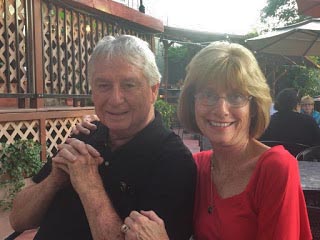Good 29º super foggy frozen morning.
Yesterday the fog was really dense. As it turns out, we had the same fog thing a year ago today.
Here is our fog and the geese on the barn roof......
And the fog in Grants Pass....
Picture of the Day
Interesting about the American Robin....
The American robin is a very widespread and familiar North American bird, and is often one of the first birds children learn to recognize and novice birders add to their life lists. But how much do you really know about these robins?
- The American robin goes by many names, including robin red-breast, just plain robin, and its scientific name, Turdus migratorius.
- European settlers named the American robin after the familiar European robin that they missed after emigrating to the New World. While both birds have orange breasts and upright postures, however, they do not otherwise look similar and are not closely related.
- American robins are part of the Turdidae family of birds, which includes roughly 180 species of related thrushes. Birds in the same family that are close cousins of robins include bluebirds, solitaires, Eurasian blackbirds, and fieldfares.

More 120 different birds around the world include "robin" in their names, which makes it very important to use full names or scientific names when referring to different birds. Other "robins" include many different chats, flycatchers, and Australasian robins that are not close relatives of the American robin.
- The American robin is the state bird of Michigan, Wisconsin, and Connecticut. This makes it one of the most popular state birds, and it is often seen in state flags, coins, shields, seals, and other symbols.
- Both male and female American robins look similar, though males are generally brighter and more boldly colored than females. There are seven different subspecies of American robin, however, and geographic variations in their plumages can be quite extreme. Populations in very humid areas, such as the Pacific Northwest, have darker plumage, while desert birds in drier regions tend to have much lighter, paler coloration.
- These are omnivorous birds that eat a wide variety of different foods, including earthworms, caterpillars, snails, spiders, berries, and fruit. In the backyard, American robins will often snack on jelly, mealworms, and suet, and they will also sample nuts and seeds, though they do not eat these foods as frequently.
What Do Robins Eat? Learn Their Favorite Foods!American robins have exceptionally keen eyesight that allows them to see the tiny disturbances in the soil that indicate where worms are moving. This is how robins find worms, though they also use their senses of hearing and touch as part of their hunting as well.
- These birds have a flexible, complex syrinx (a bird's voice box, the equivalent to the human larynx) that allows them to create highly varied, warbling songs. American robins are often part of the dawn chorus and will sing for hours to attract mates and advertise the territory they have claimed. They can be heard singing throughout the day.
- Even though American robins are often thought of as spring birds, they actually stay in most of their breeding range all year long. In winter, robins will roost in trees and their diet changes to more fruit and berries because insect populations are scarce. In the very northernmost parts of their range, these birds do migrate, but only go as far south as needed to find enough resources to wait out the winter. In mild winters, they may not migrate at all.
- While American robins are native to the New
- An American robin's nest is a deep cup that measures 3-9 inches in diameter and is made from different nesting material such as grasses, twigs, and mud.
- Some robins will even use bits of string and yarn in their nests, which they sometimes build from the inside out. The females do most of the nest building, and it can take 2-6 days to complete the nest. When finished, a robin's nest weighs roughly seven ounces.
- The characteristic robin's egg blue of an American robin's eggs is caused by hemoglobin and bile pigment's in the female's blood. As eggs are formed within her body, these pigments create the familiar blue or blue-green, unmarked shell. This does not hurt the female and she does not need a special diet to create blue eggs.
- After the eggs hatch, both American robin parents care for their chicks for 12-14 days until the youngsters leave the nest. Once the fledglings are out of the nest, however, they will not be fully independent for another 10-15 days. During that time, the parents still watch out for their offspring as the young birds learn to fly and stretch and strengthen their wings. Be sure you know what to do if you find a baby robin during this time!
- Though American robins will lay 2-3 broods of 3-5 eggs each year, only 25 percent of chicks survive for six months. The average lifespan of an American robin is just 5-6 years if the bird survives to adulthood, though some wild robins have lived as long as 12-13 years. In captivity these birds have lived up to 15-17 years.
- The current population of American robins is estimated at 310 million birds in the world. This is one of the most common backyard birds in North America and American robins are not considered threatened or endangered.
- Though American robins are common and widespread, they still face a variety of threats. Overuse of outdoor chemicals such as herbicides, pesticides, and fertilizers can be dangerous to robins as they feed on lawns. Feral or outdoor cats and window collisions are other grave threats to robins.
- American robins are part of Indigenous folklore for several tribes. While legends vary, many tribes consider the American robin a symbol of peace, safety, and nurturing. There are also legends that consider the robin either a guardian of fire or a thief of flames, and those stories explain the origins of the robin's orange-red breast.
The American robin is popular in modern culture and is often featured on winter holiday cards. The robin has also been the subject of song, including the hits Rockin' Robin (Bobby Day, 1958) and When the Red, Red Robin Comes Bob, Bob, Bobbin' Along (Harry M. Woods, 1926).
From Mr. Food
If you're feeling down in the dumps and need a soup recipe to push away those winter blues, then our easy recipe for Feel-Good Soup is sure to lift your spirits. With a combination of chicken, veggies, and some of your favorite seasonings, it's truly a soup recipe you're going to be making for years to come.
- 2 tablespoons vegetable oil
- 2 pounds boneless, skinless chicken breasts, cut into 1/2-inch chunks
- 6 cloves garlic, minced
- 8 cups water
- 1 (10-ounce) package fresh baby spinach
- 4 carrots, thinly sliced
- 6 chicken bouillon cubes
- 1/2 teaspoon black pepper
- In a soup pot, heat oil over high heat. Add chicken and garlic and saute for 5 minutes, or until no pink remains in the chicken.
- Add remaining ingredients and bring to a boil. Reduce heat to medium low, cover and simmer 15-20 minutes, or until the carrots are tender.
^with his Jeannie
and..another special birthday....
Al Rodriguez (LASD)
Historically this date....
1943 – The world's largest office building, The Pentagon, is dedicated in Arlington, Virginia.
1947 – The brutalized corpse of Elizabeth Short ("The Black Dahlia") is found in Leimert Park, Los Angeles.
1967 – The first Super Bowl is played in Los Angeles, California. The Green Bay Packers
defeat the Kansas City Chiefs 35-10
2009 – US Airways Flight 1549 makes an emergency landing in the Hudson River shortly after takeoff from LaGuardia Airport in New York, New York. All passengers and crew members survive.
And births this date include...
1913 – Lloyd Bridges, American actor (d. 1998)
1929 – Martin Luther King, Jr., American civil rights leader, recipient of the Nobel Peace Prize (d. 1968)
1979 – Drew Brees, American football player
All I know. Nuff said. Have a good Saturday. Ciao.
xo Sue Mom Bobo
Hang on to your hats and celebrate in style on National Hat Day. Celebrated each year on January 15th, don your favorite fedora, cap, cloche, derby or sunhat. Dig out your ceremonial best and tell the story behind it. Wear your warmest tuque, stocking cap, beanie and share the name you give it. There are so many hats, fashions and names we give them. Certainly, we could wear a hat a day and never get through them all.
- Hats may be worn for safety and protection, religious reasons, ceremonial reasons, warmth or fashion.
- In the Middle Ages, hats were an indicator of social status.
- In the military, hats may denote one’s nationality, branch of service, rank and/or regiment.
- A Thebes tomb painting depicts one of the first pictorials of a hat. The painting shows a man wearing a conical straw hat.
- Structured hats for women began to be worn in the late 16th century.
- Millinery is the designing and manufacture of hats.
- The term “milliner” derived from the city of Milan, Italy. The best quality hats were made in Milan in the 18th century.
- Millinery began as traditionally a woman’s occupation, as the milliner not only created hats and bonnets but also chose lace, trim and accessories to complete an outfit.
- In the middle of the 1920s, to replace the bonnets and wide-brimmed hats, women began to wear smaller hats that hugged their heads.
Depending on where you live, if you are outside in the middle of a cold January, you may definitely want to wear a hat on National Hat Day!
NATIONAL HAT DAY HISTORY
Since at least 1983, National Hat Day has been observed in libraries, schools, and museums across the country. They invited students and patrons to wear their favorite hats or hats of their occupation. People of all ages show up in pirate hats and football helmets. Patrol officers, postal workers, restaurant servicers also wear their hats to various events.



















2 comments:
What a cheerful post to start the day with.
Thank you for the reminder to clean and fill the bird feeders.
MLK jr is a hero of mine. “ Even if I am called to be a street sweeper, let me sweep the streets Michelangelo painted.”
I pray for the day we can shed these shrouds of anonymity- covered head to foot in dreary colors. Regain the acts of community. Relearn trust.
LOL So today is National Hat Day! :) I am known at the Hat Lady. :) We went out and had breakfast this morning with Art and Carol Herrera and for once I didn't wear a hat! :) I didn't know! :(
XO Trisha
Post a Comment